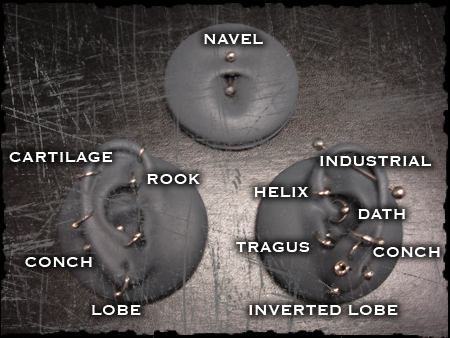
Piercing
We offer piercing services 7 days a week.
All piercings are done on a walk-in basis. Piercing hours are subject to change so please call before you come down to make sure there is availability.
NOTICE:
You must be 18 with a valid state or government issued ID to receive a piercing (i.e.: DL, passport, military ID). The ID must be present with you at the time you wish to have the procedure. We will not accept copies or photographs of IDs. We do not accept college IDs and we DO NOT pierce minors even with parental consent.

PRICING
Please call the shop for pricing.
Jinx Proof Piercing Care Instructions
Use either one or both of the following solutions for body piercing:
Packaged saline solution with no additives, or a non-iodized sea salt mixture, consisting of dissolving 1/8 to 1/4 teaspoon of non-iodized sea salt into 8 ounces of warm, distilled or bottled water. A stronger mixture is not better. Saline solution that is too strong can irritate the piercing.
-or-
A liquid, antimicrobial or germicidal soap.
Cleaning instructions
- 1- Wash your hands thoroughly prior to cleaning. No touching on or near your piercing for any reason.
- 2- Saline soak at least 2 to 3 times daily. Invert a cup of warm saline over the area to form a vacuum for a few minutes or spray it directly on to the piercing.
- 3- Soap, no more than once or twice a day. Lather up a pearl size drop of the soap to clean the jewelry and the piercing. Leave the cleanser on the piercing no more than 30 seconds and rinse thoroughly to remove all traces of the soap from the piercing.
- Do not remove the jewelry from the piercing to clean.
- 4- You may dry your piercing with disposable paper products, such as gauze or tissues, cotton swabs or cotton rounds, since cloth towels can harbor bacteria and catch on new piercings, causing injury. Pat gently to avoid trauma & transferring cotton wisps or you may simply let it air dry.
What is normal?
- Initially: some bleeding, localized swelling & tenderness, or bruising.
- During healing: some discoloration, itching, secretion of a whitish/yellow fluid that will form some crust on the jewelry. The tissue may tighten around the jewelry as it heals.
- Once healed: the jewelry may not move freely in the piercing, do not force it, clean it gently instead.
- If you fail to include cleaning your piercing as part of your daily hygiene routine, normal, but smelly body secretions may accumulate. Again, it is best to just clean gently.
- A piercing may seem healed before healing is actually complete. This is because piercings heal from the outside in, and although it feels healed, the tissue remains fragile on the inside. Be patient, and keep cleaning throughout the entire healing period.
- Piercings can shrink or close in minutes if the jewelry is removed, even after having been there for years. This varies from person to person.
- If you like your piercing, leave the jewelry in place, and if you’re not confident in changing it yourself, have your piercer change it for you.
The importance of downsizing:
Inflammation occurs when you’re pierced. To accommodate this, you’re pierced with longer/ larger jewelry initially. After time, the swelling will dissipate and you will need a shorter post that won’t “rattle” or move about, and fitted to your body accordingly.
What to do
- Always wash your hands prior to touching the piercing & leave it alone, except when cleaning. It is not necessary to rotate the jewelry while healing.
- Stay healthy. Get enough sleep and eat a nutritious diet. The healthier the lifestyle, the easier it will be for your piercing to heal. Exercise during healing is fine. Just listen to your body.
- Make sure your bedding is kept clean and changed regularly. Wear clean, comfortable, breathable clothing that protects your piercing while sleeping.
- Showering is more advisable than taking a bath, because bathtubs tend to harbor bacteria. If you would like to take a bath, clean the tub well before each use.
What to avoid
- Avoid undue trauma such as friction from clothing, excessive motion of the area, playing with the jewelry and vigorous cleaning. These activities can cause the formation of unsightly and uncomfortable scar tissue, migration, prolonged healing, and other complications, like localized piercing pimples.
- Avoid the use of alcohol, hydrogen peroxide, Betadine, or ointments.
- Avoid over cleaning. This can delay your healing and irritate your piercing.
- Avoid all oral contact, rough play or contact with others bodily fluids on or near your piercing during healing.
- Avoid submerging the piercing in bodies of water, such as lakes pools, hot tubs, etc. or protect your piercing, using a special waterproof bandages, such as Tegaderm, which are available at drugstores.
- Avoid all beauty and personal care products on or around the piercing, which includes cosmetics, lotion, sprays, etc.
- Don’t hang any charms or any object from your jewelry until the piercing is fully healed.
Hints and tips
- Unless there is a problem with the size, style or material of the initial jewelry, leave it in place for the entire healing. A qualified piercer should perform any necessary jewelry change that occurs during healing.
- Contact your piercer if your jewelry must be temporarily removed, such as for a medical procedure. There are non-metallic jewelry alternatives.
- Leave jewelry in at all times. As mentioned, even an old, well healed piercing can shrink in minutes if removed. Reinsertion can be difficult or impossible, but with the right tools it can be done by a professional. Don’t try and “jam” your jewelry back in. If you can’t put it in yourself, go see your piercer.
- With clean hands, be sure to regularly check threaded ends on your jewelry for tightness.
- Carry a clean, spare ball in case of loss or breakage.
Should you decide you no longer want your piercing, seek professional help in the removal of the jewelry. Continue cleaning the piercing until the hole closes. In most cases only a small indentation will remain.
In the event that an infection is suspected, quality jewelry, or an insert alternative should be left in place to allow for drainage of the infection. Should the jewelry be removed, the surface cells can close up, sealing the infection inside the piercing channel resulting in an abscess.
Until such time the infection is cleared up, leave quality jewelry in.
For particular areas
Navel Piercings:
If needed, a hard, vented eyepatch, which are sold pharmacies can be applied under tight clothing or secured with an ace bandage. This can protect the area from restrictive clothing, excessive irritation, and impact during physical activities such as contact sports.
Ear, cartilage, and facial:
- Use the T-shirt trick- cover your pillow with a large clean T-shirt and turn it nightly. One clean T-shirt provides four clean surfaces to sleep on.
- Buy a Piercing Pillow or a travel pillow and use it to cradle your ear if you are a side sleeper.
- Maintain cleanliness of telephones, headphones, eyeglasses, helmets, hats, and anything that comes in contact with the pierced area.
- Use caution when styling your hair, and advise your stylist of a new or healed piercing.
For nipple piercings:
The support of a tight, cotton shirt or a sports bra may provide protection and feel comfortable especially for sleeping.
For genital piercings:
In most cases, you can engage in sexual activity as soon as you feel ready. Comfort and hygiene are vital.
- During healing: all sexual activities must be gentle to increase comfort and decrease trauma. Soak in warm saline solution, or plain water to remove any crusty matter prior to sexual activity.
- Use barriers such as Condoms, dental dams, and Tegaderm, etc. to avoid contact with a partners bodily fluids, even in long-term relationships.
- Use clean, disposable barriers on sex toys.
- Wash hands before touching on or near the piercing.
- Use a new container of water-based lubricant. Do not use your own saliva as lubricant.
- After sex, an additional saline soak or clean water rinse is suggested.
- Prince Albert and Apadravya piercings can bleed freely for the first few days.
- If using soap, urinate after cleaning any piercing that is near the urethra.
Each body is unique and healing times vary considerably. If you have any questions, please contact your Piercer.
